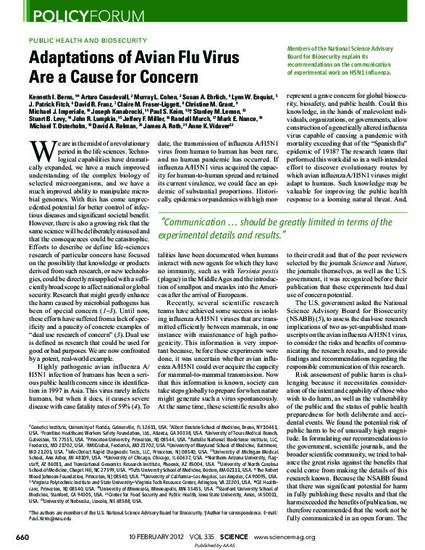
Article
Adaptations of Avian Flu Virus Are a Cause for Concern
Science
Document Type
Article
Disciplines
Publication Version
Published Version
Publication Date
2-1-2012
DOI
10.1126/science.1217994
Abstract
We are in the midst of a revolutionary period in the life sciences. Technological capabilities have dramatically expanded, we have a much improved understanding of the complex biology of selected microorganisms, and we have a much improved ability to manipulate microbial genomes. With this has come unprecedented potential for better control of infectious diseases and significant societal benefit. However, there is also a growing risk that the same science will be deliberately misused and that the consequences could be catastrophic. Efforts to describe or define life-sciences research of particular concern have focused on the possibility that knowledge or products derived from such research, or new technologies, could be directly misapplied with a sufficiently broad scope to affect national or global security. Research that might greatly enhance the harm caused by microbial pathogens has been of special concern (1–3). Until now, these efforts have suffered from a lack of specificity and a paucity of concrete examples of “dual use research of concern” (3). Dual use is defined as research that could be used for good or bad purposes. We are now confronted by a potent, real-world example.
Rights
Works produced by the U.S. Government are not copyrighted within the U.S. The content of this document is not copyrighted.
Language
en
File Format
application/pdf
Citation Information
Kenneth I. Burns, Arturo Casadevall, Murray L. Cohen, Susan A. Ehrlich, et al.. "Adaptations of Avian Flu Virus Are a Cause for Concern" Science Vol. 335 Iss. 6069 (2012) p. 660 - 661 Available at: http://works.bepress.com/james_roth/36/

This article is from Science 335 (2012): 660, doi:10.1126/science.1217994.